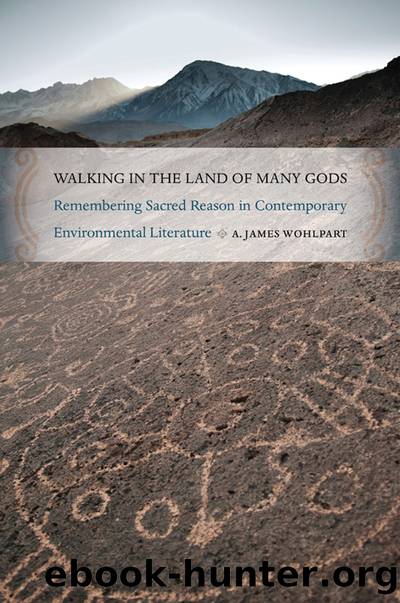Walking in the Land of Many Gods by A. James Wohlpart

Author:A. James Wohlpart
Language: eng
Format: epub
Publisher: University of Georgia Press
Published: 2013-01-15T00:00:00+00:00
CHAPTER FIVE
Healing the Severed Trust
Linda Hoganâs Dwellings: A Spiritual History of the Living World as Native Ceremony
In The Sacred Hoop, Paula Gunn Allen identifies two basic forms of Native American literature, the ceremony and the myth. According to Allen, âthe ceremony is the ritual enactment of a specialized perception of a cosmic relationship, while the myth is a prose record of that relationship.â1 Both forms have the purpose of locating the individual within an interlocking and interconnected framework that includes the psychological, the social, the geographical, and the spiritual, all the way out to the cosmic. This holistic perception of the worldâvery different from the scientific, calculative way of thinking that separates and isolates things as resource-objects for our useâconnects humans to the landscape and all the beings who grace the world around us. Ceremony plays a particular role in this way of thinking, for its purpose âis to integrate: to fuse the individual with his or her fellows, the community of people with that of the other kingdoms, and this larger communal group with the worlds beyond this one. A raising or expansion of individual consciousness naturally accompanies this process. The person sheds the isolated, individual personality and is restored to conscious harmony with the universe.â2 Allen states that because individuals from the West fail to think in this holistic way, in which all beings are interconnected, they very often struggle with an authentic understanding of the great power that exists in Native American literature. The structures and symbols of this literature âare designed to integrate the various orders of consciousness,â not only within and among humans but also between humans and other entities who also participate in the ceremonial literature.3 Most importantly, the literature itself is an âenactment of [this] specialized perceptionâ of the cosmic interrelationship grounding our existence, not merely a record or description but an unfolding, a presencing of that way of thinking and thus, concomitantly, of the reciprocal appropriation, in Momadayâs words, that pervades reality.
In her essay âFirst People,â Linda Hogan mirrors Allenâs depiction of Native American literature as embodying a cosmic interrelationship, describing the way in which ceremonies can heal the rift that has grown between the self and the world. She says: âThe stories that are songs of agreement and safekeeping, and the ceremonies that are their intimate companions, tell us not only how to keep the world alive, they tell us how to put ourselves back together again. In the language of ceremony, a person is placedâbodily, socially, geographically, spiritually, and cosmologicallyâin the natural world extending all the way out into the universe. This placing includes the calling in of the animal presence from all directions.â In this passage, Hogan connects storytelling with ceremony and notes that they both allow us to find our place in the intricate web of the natural world that sustains us and the cosmological order that grounds our existence. Moreover, stories and ceremonies are a happening, a lived event that places us within both the cultural and the natural worlds in such a way that we are restored to balance and the world is kept alive.
Download
This site does not store any files on its server. We only index and link to content provided by other sites. Please contact the content providers to delete copyright contents if any and email us, we'll remove relevant links or contents immediately.
| Native American | Popol Vuh |
| Rastafari Movement |
The Four Agreements by Don Miguel Ruiz(6622)
Breaking Free by Rachel Jeffs(4174)
The Hatha Yoga Pradipika (Translated) by Svatmarama(3227)
120 Days of Sodom by Marquis de Sade(3177)
Member of the Family by Dianne Lake(2302)
The Tao of Physics by Fritjof Capra(2227)
The Psychedelic Gospels: The Secret History of Hallucinogens in Christianity by Jerry B. Brown(2121)
The Road to Jonestown by Jeff Guinn(2019)
Going Clear: Scientology, Hollywood, and the Prison of Belief by Lawrence Wright(1935)
Going Clear by Lawrence Wright(1921)
Uriel's Machine by Christopher Knight(1862)
The Grand Grimoire: The Red Dragon by Author Unknown(1759)
The Gnostic Gospel of St. Thomas by Tau Malachi(1736)
Key to the Sacred Pattern: The Untold Story of Rennes-le-Chateau by Henry Lincoln(1593)
The Malloreon: Book 02 - King of the Murgos by David Eddings(1554)
Waco by David Thibodeau & Leon Whiteson & Aviva Layton(1530)
The New World Order Book by Nick Redfern(1525)
Animal Speak by Ted Andrews(1513)
The Secret of the Temple by John Michael Greer(1463)
